Related Research Articles

The breast is one of two prominences located on the upper ventral region of a primate's torso. Both females and males develop breasts from the same embryological tissues.

An infant or baby is the very young offspring of human beings. Infant is a formal or specialised synonym for the common term baby. The terms may also be used to refer to juveniles of other organisms. A newborn is, in colloquial use, an infant who is only hours, days, or up to one month old. In medical contexts, a newborn or neonate is an infant in the first 28 days after birth; the term applies to premature, full term, and postmature infants.

The nipple is a raised region of tissue on the surface of the breast from which, in females, milk leaves the breast through the lactiferous ducts to feed an infant. The milk can flow through the nipple passively or it can be ejected by smooth muscle contractions that occur along with the ductal system. Male mammals also have nipples but without the same level of function, and often surrounded by body hair.

A mammary gland is an exocrine gland in humans and other mammals that produces milk to feed young offspring. Mammals get their name from the Latin word mamma, "breast". The mammary glands are arranged in organs such as the breasts in primates, the udder in ruminants, and the dugs of other animals. Lactorrhea, the occasional production of milk by the glands, can occur in any mammal, but in most mammals, lactation, the production of enough milk for nursing, occurs only in phenotypic females who have gestated in recent months or years. It is directed by hormonal guidance from sex steroids. In a few mammalian species, male lactation can occur. With humans, male lactation can occur only under specific circumstances.

Hyperprolactinaemia is the presence of abnormally high levels of prolactin in the blood. Normal levels average to about 13 ng/mL in women, and 5 ng/mL in men, with an upper normal limit of serum prolactin levels being 15-25 ng/mL for both. When the fasting levels of prolactin in blood exceed this upper limit, hyperprolactinemia is indicated.

Areolar glands, also known as glandulae areolares, Montgomery glands, and tubercula areolae, are 10-15 elevations found on the areola. They are usually arranged in a circle around the nipple, and can be particularly visible when the nipple is erect. Their role is to promote adequate breastfeeding of the infant.

Breast milk or mother's milk is milk produced by mammary glands located in the breast of a human female. Breast milk is the primary source of nutrition for newborns, containing fat, protein, carbohydrates and variable minerals and vitamins. Breast milk also contains substances that help protect an infant against infection and inflammation, whilst also contributing to healthy development of the immune system and gut microbiome.
Galactorrhea or lactorrhea is the spontaneous flow of milk from the breast, unassociated with childbirth or nursing.

A galactagogue, or galactogogue, also known as a lactation inducer or milk booster, is a substance that promotes lactation in humans and other animals. It may be synthetic, plant-derived, or endogenous. They may be used to induce lactation and to treat low milk supply.

Neonatal jaundice is a yellowish discoloration of the white part of the eyes and skin in a newborn baby due to high bilirubin levels. Other symptoms may include excess sleepiness or poor feeding. Complications may include seizures, cerebral palsy, or kernicterus.

Lactational amenorrhea, also called postpartum infertility, is the temporary postnatal infertility that occurs when a woman is amenorrheic and fully breastfeeding.

Breastfeeding difficulties refers to problems that arise from breastfeeding, the feeding of an infant or young child with milk from a woman's breasts. Although babies have a sucking reflex that enables them to suck and swallow milk, and human breast milk is usually the best source of nourishment for human infants, there are circumstances under which breastfeeding can be problematic, or even in rare instances, contraindicated.

Breastfeeding, or nursing, is the process by which human breast milk is fed to a child. Breast milk may be from the breast, or may be pumped and fed to the infant. The World Health Organization (WHO) recommends that breastfeeding begin within the first hour of a baby's life and continue as often and as much as the baby wants. Health organizations, including the WHO, recommend breastfeeding exclusively for six months. This means that no other foods or drinks, other than vitamin D, are typically given. The WHO recommends exclusive breastfeeding for the first 6 months of life, followed by continued breastfeeding with appropriate complementary foods for up to 2 years and beyond. Of the 135 million babies born every year, only 42% are breastfed within the first hour of life, only 38% of mothers practice exclusive breastfeeding during the first six months, and 58% of mothers continue breastfeeding up to the age of two years and beyond.

Lactation describes the secretion of milk from the mammary glands and the period of time that a mother lactates to feed her young. The process naturally occurs with all sexually mature female mammals, although it may predate mammals. The process of feeding milk in all female creatures is called nursing, and in humans it is also called breastfeeding. Newborn infants often produce some milk from their own breast tissue, known colloquially as witch's milk.

Gynecomastia is the abnormal non-cancerous enlargement of one or both breasts in males due to the growth of breast tissue as a result of a hormone imbalance between estrogens and androgens. Gynecomastia can cause significant psychological distress or unease.

Latch refers to how the baby fastens onto the breast while breastfeeding. A good latch promotes high milk flow and minimizes nipple discomfort for the mother, whereas poor latch results in poor milk transfer to the baby and can quickly lead to sore and cracked nipples. In a good latch, both the nipple and a large portion of the areola are in the baby's mouth.
In breastfeeding women, low milk supply, also known as lactation insufficiency, insufficient milk syndrome, agalactia, agalactorrhea, hypogalactia or hypogalactorrhea, is the production of breast milk in daily volumes that do not fully meet the nutritional needs of her infant.

Delayed onset of lactation (DOL) describes the absence of copious milk secretion (onset of lactation) within the first 72 hours following childbirth. It affects around 20–40% of lactating women, the prevalence differs among distinct populations.
Nipple pain is a common symptom of pain at the nipple that occurs in women during breastfeeding after childbirth. The pain shows the highest intensity during the third to the seventh day postpartum and becomes most severe on the third day postpartum.

Establishment of breastfeeding refers to the initiation of providing breast milk of mother to baby. According to the World Health Organisation(WHO), breastfeeding is the best way to provide nourishment, including essential nutrients, energy and antibodies, to infants and toddlers. The start of breastfeeding is supported by the milk production which depends on the development of internal and external breast structure and hormonal control on milk secretion. Besides milk supply, adopting the correct approach of breastfeeding helps build up the maternal bond, which in turn promotes breastfeeding. Not only does nursing strengthen the mother-child relationship, but it also improves the intelligence and immunity of breastfed children and diminishes breastfeeding mothers' risks to have ovarian and breast cancer.
References
- 1 2 3 Devidayal (2005). "A Male Infant with Gynecomastia-Galactorrhea". The Journal of Pediatrics. 147 (5): 712. doi:10.1016/j.jpeds.2005.06.026. PMID 16291370. "full text" (PDF).
- 1 2 3 Madlon-Kay, D. J. (1986). "'Witch's milk'. Galactorrhea in the newborn". American Journal of Diseases of Children. 140 (3): 252–253. doi:10.1001/archpedi.1986.02140170078035. PMID 3946357.
- ↑ Yap, P. L.; Mirtle, C. L.; Harvie, A.; McClelland, D. B. (1980). "Milk protein concentrations in neonatal milk (witch's milk)". Clinical and Experimental Immunology. 39 (3): 695–697. PMC 1538139 . PMID 7379333.
- ↑ Paturi, B.; Ryan, R. M.; Michienzi, K. A.; Lakshminrusimha, S. (2009). "Galactorrhea with metoclopramide use in the neonatal unit". Journal of Perinatology. 29 (5): 391–392. doi:10.1038/jp.2008.246. PMID 19398999.
- ↑ Weimann, E. (2003). "Clinical management of nipple discharge in neonates and children". Journal of Paediatrics and Child Health. 39 (2): 155–156. doi:10.1046/j.1440-1754.2003.00118.x. PMID 12603810. S2CID 34248317.
- ↑ Potts, Malcolm (1999). Ever Since Adam and Eve: The Evolution of Human Sexuality . p. 145. ISBN 978-0521644044.
